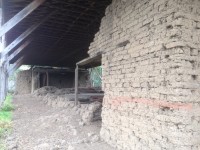I have always had an insatiable desire to glimpse what’s on the other side of the mountain. Here in Sinai, I must make an important decision. Do I take my son Andrew beyond the safety of Sharm-el-Sheikh, a well-fortified tourist town situated on the Red Sea, to turn stones in Sinai’s interior? Al-Qaeda-linked jihadists such as Ansar Bayt al-Maqdis have been recently causing turmoil in the region, targeting tourists. The group is supported by Bedouin populations and Hamas reigning from the Gaza region of northern Sinai.
Sharp jagged mountain peaks rise from the nearby shores of the Red Sea and the Sea of Aqaba. The salty waters of Aqaba dance along the shorelines of Egypt, Israel, Jordan and Saudi Arabia. Geologically, these mountains are made of basalt, a testament to the volcanic activities that encompassed the area millions of years ago, while the interior Sinai mountains are comprised of sandstones, chalk full of fossilized sea life. I want to instill in Andrew my lust to get lost, anywhere lost, to explore the unknown… so we go.
To leave Sharm, we are required to hire a driver, bodyguard and guide. The bodyguard was conspicuous, I suppose by design. He wore a full-length leather coat and the butt of his Russian-made AK-47 protruded awkwardly from under his sweater. Our destination would take us three hours into the heart of the Sinai, to one of the most holy places on Earth, the Holy Monastery known today as St. Catherine.
This is the site of the Burning Bush and the location where Moses received the revelation of the law. Rising high above the monastery is Mt. Sinai, known locally as Mt. Moses, and is the location where he received the Ten Commandments from God. No matter what direction one turns to regarding religion, here, every step is steeped in a sacred aura.
In the third century Christians came to the area to avoid persecution. The goal was to create a place of worship at a location of unparalleled sanctity and a little difficult to find. In 330 AD a church was constructed at the base of Mt. Sinai. We entered the church to find a monk praying at the alter. Talking is not allowed within the walls of the church, thus it was easy to simply soak in the ancient images painted on the interior walls. It’s antiquity alone was amazing; St. Catherine is the oldest continuously occupied Christian monastery in the world.
Immediately adjacent to the church, there is a well. This well is where Moses not only drank, but met his wife. A few steps beyond the well, there is a massive bush, considered to be the burning bush mentioned in the bible. There is a tranquility here reminiscent of a sweet cup of mint tea, a bedouin favorite.
The monastery was built in the 7th century. Justinian was responsible for its construction, sending two hundred families from the Pontos of Anatolia and from Alexandria. Their purpose was to guard, defend and assist the monks. The Jebeliya tribe of bedouin peoples living their today are the descendants of those families. Because these original protectors had European affiliations, some of the Jebeliya have blue eyes and red hair. They are proud of their Greek and Roman origins.
In the Arabic language, those that live out in the desert are known as “bedouin.” The Jebeliya converted to Islam in the 7th century, but have always maintained and protected the monastery for 17 centuries. They have a symbiotic relationship with the land and honor the responsibilities bestowed upon their ancestors.
The serenity and natural beauty of the Sinai is countered by a land of complete unrest. It’s a dichotomy hard to understand. As we began our journey I told my guide I would ask only once, do you think things will be safe today. He smiled and said I have a family too. We were rewarded by the hospitality of the Jebeliya and the warmth of the lithic surroundings of the Sinai.


Be First to Comment